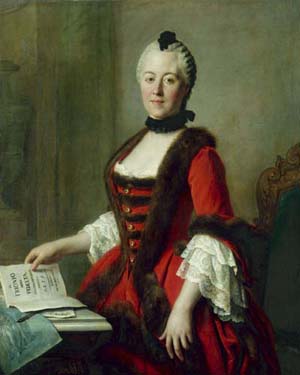Duchess Maria Antonia of Bavaria facts for kids
Quick facts for kids Maria Antonia |
|||||
|---|---|---|---|---|---|

Portrait by Anton Raphael Mengs
|
|||||
| Electress consort of Saxony | |||||
| Tenure | 5 October 1763 - 17 December 1763 | ||||
| Born | 18 July 1724 Nymphenburg Palace, Munich |
||||
| Died | 23 April 1780 (aged 55) Dresden |
||||
| Burial | Katholische Hofkirche | ||||
| Spouse |
Frederick Christian, Elector of Saxony
(m. 1747; died 1763) |
||||
| Issue | Frederick Augustus I, King of Saxony Anthony, King of Saxony Maria Amalia, Duchess of Zweibrücken Maximilian, Crown Prince of Saxony |
||||
|
|||||
| House | Wittelsbach | ||||
| Father | Charles VII, Holy Roman Emperor | ||||
| Mother | Maria Amalia of Austria | ||||
| Religion | Roman Catholicism | ||||
Maria Antonia was a talented German princess. She was born on July 18, 1724, and passed away on April 23, 1780. Maria Antonia was a composer, singer, and played the harpsichord. She also supported many artists. She is famous for her operas, especially Il trionfo della fedeltà and Talestri, regina delle amazoni. She became the Electress of Saxony when she married Frederick Christian, Elector of Saxony. After her husband died in 1763, she became a regent. This meant she ruled Saxony for her young son, Frederick Augustus I of Saxony.
Contents
Early Life and Education
Maria Antonia was born at Nymphenburg Palace in Munich. Her parents were Archduchess Maria Amalia of Austria and Elector Karl Albert of Bavaria. She was given the full name Maria Antonia Walpurgis Symphorosa.
She was the fourth of seven children in her family. Maria Antonia received an excellent education. She learned about painting, writing poetry, and especially music.
Her Marriage and New Home
Maria Antonia married Frederick Christian, Elector of Saxony. Their first wedding ceremony happened in Munich on June 13, 1747. This was a proxy marriage, meaning someone stood in for the groom. They then had a second wedding in person in Dresden on June 20, 1747.
After her marriage, she moved to Dresden. In the same year, she joined an important group in Rome called the Accademia dell’Arcadia. This group was working to improve opera. Maria Antonia and Frederick Christian had nine children together. Seven of their children lived past infancy.
Becoming a Regent
During the Seven Years' War, Maria Antonia left Dresden. She found safety in Prague and Munich. She returned to Dresden in 1763 when her husband became the ruler. Sadly, he died just ten weeks later.
Their son, Frederick Augustus, became the new ruler. Since he was still young, Maria Antonia became a regent. She ruled Saxony along with her brother-in-law, Franz Xavier. They ruled together until her son was old enough in 1768.
During her time as regent, she made important decisions. She did not agree with her co-regent's plan to give up her son's claim to the Polish throne in 1765. She also helped the economy. She started a textile factory in 1763 and a brewery in 1766.
Musical Talents and Compositions
Maria Antonia loved music and was very talented. While in Munich, she studied music with famous opera composers Giovanni Battista Ferrandini and Giovanni Porta. After moving to Dresden, she continued her studies with other great musicians like Giovanni Alberto Ristori, Nicola Porpora, and Johann Adolph Hasse.
Opera was a huge part of her life. Her birth was celebrated with an opera performance. Her engagement was also celebrated with operas by composers like Hasse and Gluck.
Maria Antonia didn't just perform; she also composed. She wrote the words for Hasse’s oratorio, La conversione di Sant’Agostino (1750). Her own music style was very similar to Hasse's, especially in serious operas. She was also an active performer. She sang and played the keyboard in court performances. She even played leading roles in her own operas. Besides her two operas, she wrote many songs, a pastorale, and other musical pieces.
Her Opera Talestri
One of Maria Antonia's most famous works is the opera Talestri, regina delle amazoni. This opera is about Thalestris, a queen of the Amazons. Stories about the Amazons are found in Greek mythology and were popular for a long time.
Maria Antonia wrote both the story (called the libretto) and the music for her opera. The story focuses on Talestris's relationship with a Scythian ruler named Orontes. The opera also features two other important women: Antiope, Talestris's advisor, and Tomiris, the high priestess. Tomiris is later revealed to be Orontes's mother.
The opera has a happy ending. All the couples are united, and war is avoided. The Scythians and Amazons learn to live together peacefully. The way Talestris is shown as a kind and thoughtful leader might suggest that Maria Antonia saw some of herself in the character.
Her Major Works
- Il trionfo della fedeltà: An opera with a story written by Maria Antonia herself. It was first performed in Dresden in the summer of 1754.
- Talestri, regina delle amazoni: Another opera with a story written by Maria Antonia. It was first performed in Nymphenburg on February 6, 1760.
See also
 In Spanish: María Antonia de Baviera para niños
In Spanish: María Antonia de Baviera para niños


